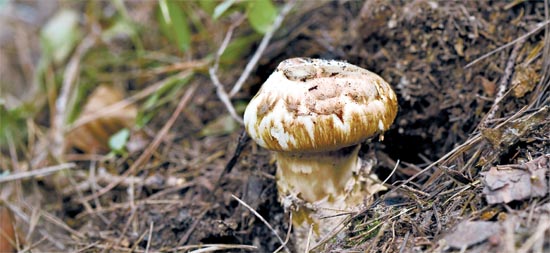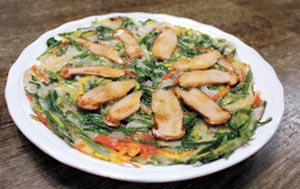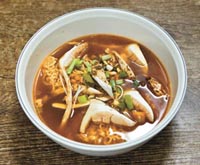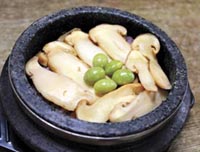Where the pine mushroom grows

Pine mushrooms are often dubbed the mushroom of fall because they are only available between September and October. [JoongAng Ilbo]
October deserves to be designated the month of the pine mushroom. This wild fungus is harvested between mid-September and October, meaning that fresh pine mushrooms are only available for one month of the year.
Pine mushrooms, or songi in Korean, are known to reduce bad cholesterol and improve circulation. They are also rich in protein yet low in fat.
But the main reason for the pine mushroom’s popularity is its strong aroma, which stays with you even after the mushroom has been consumed. Some say that pine mushrooms smell like pine trees, while others will tell you that the scent is more like a combination of earth and cinnamon.
There are three major pine mushroom producing regions in Korea: Bonghwa and Uljin in North Gyeongsang and Yangyang in Gangwon. I traveled to two of these regions late last month to find out more about the fragrant fungus.
My first stop was Bonghwa, and when I arrived at the intercity bus terminal, I was met by pine mushroom wholesaler Lim Jong-won, 50, who guided me to a nearby mountain thick with lush trees. After about 20 minutes of hiking, we ran into a “no trespassing” sign. According to Lim, the sign was put up to guard against the crowds of people who try to sneak up the mountain to steal mushrooms.
After another 10 minutes, we saw a small tent that had been placed there to ward off potential mushroom thieves. Keeping watch in front of the tent was Kim Kyo-min, 48, one of the owners of the mountain who also works as a mushroom picker.
Kim invited us to have a quick snack of instant ramen. Before serving it, he added several strips of pine mushrooms. Although Kim had used mushrooms that were not top grade, the concoction was delicious and the pine mushrooms elevated the ramen to gourmet class.
After we’d stuffed our stomachs with the hearty stew, Kim and I headed out to find some mushrooms. Along the way, he told me that it has not been easy to find the mushrooms this year because of the weather.
“It seems like we’re going to have fewer mushrooms this year than last,” Kim said. “The ideal temperature for mushroom growth is between 19 and 25 degrees Celsius [66 and 77 degrees Fahrenheit]. This year was way too hot and humid.”
It took us about 30 minutes to find five pine mushrooms, all of which were covered by soil underneath a stand of trees. Kim held out a stick that was about one-meter tall (3.28 feet) and asked me to use it to dig out the mushrooms. When I did, there was a lot of white soil left behind. According to Kim, the white particles are the mushroom’s fungus. Kim explained that another pine mushroom would grow out of the same spot next year. I grabbed a handful of soil and it smelled like a pine mushroom.
The next day I headed to Yangyang to meet Kwon Sun-ro, 58, who picks pine mushrooms there. Kwon repeated Kim’s comments about the difficulty of finding pine mushrooms because of the weather.
“This just shows that pine mushrooms truly are products of nature,” Kwon said. “If the environmental conditions aren’t good, it’s hard to get them.”
Kwon gave me some more tips on how to find the mushrooms. They are most commonly found underneath small trees, not large ones.
Unfortunately, this trip was not as fruitful as the last. We searched for an hour but had to leave empty handed.
My final destination was a market in Yangyang, where all the pine mushrooms grown within the region are collected and graded.
There are four grades for pine mushrooms. Grade A pine mushrooms must be longer than eight centimeters and the caps closed. Grade B mushrooms must be between six and eight centimeters tall with two-thirds of the caps closed. Grade C mushrooms are smaller than six centimeters.
As of Sept. 27, a kilogram (2.2 pounds) of Grade A pine mushrooms was selling for 523,600 won ($454), Grade B mushrooms were 363,600 won and Grade C mushrooms were 313,700 won.
If you are searching for a more reasonable price, mushroom pickers recommend Grade D mushrooms, which in Korean are gaesanpum. These mushrooms are overripe and have only a third of their caps - but they are second to none in terms of fragrance.
“Since supply has failed to keep pace with demand this year because of the weather, the average mushroom price has increased about 100,000 won per kilogram,” Kwon said. “But gaesanpum mushrooms are worth a try. They still have a good fragrance.”
There are also off-grade pine mushrooms that are misshapen, worm-eaten or soggy, but they can still be eaten.
Pine mushroom sellers
- Bonghwa: Bonghwa Jayeon Song-yi (054) 673-7010; Bonghwa Singsing Song-yi (054) 673-3526; Songlim Mulsan (054) 673-5106; Bonghwa Yutong (054) 673-0970
- Yangyang: Song-yi Mart (033) 672-5577; Song-yi Town (033) 673-1436; Sangwabada (033) 671-9954
The market price of pine mushrooms is updated daily on the Web site of the National Forestry Cooperatives Federation: www.nfcf.or.kr.
Simple pine mushroom recipes
Pine mushrooms are such a commodity that they are generally only used in high-end cuisine, but there are some simple recipes that you can try at home. One thing you should remember when cooking the mushrooms is to refrain from using spicy or strong ingredients, such as garlic or red pepper, because they overwhelm the mushrooms’ unique fragrance.
There are no specific measurements for the ingredients in the recipes below, giving you a chance to experiment.
- Songi beoseot jeon (Pine mushroom pancake)

- Pine mushroom ramen

- Grilled pine mushrooms

By Lee Sang-eun [so@joongang.co.kr]
한글 관련 기사 [중앙일보]
[food&] 10월의 맛 | 송이
아낌없이 주는 숲이 딱 한달만 내놓는 선물
10월은 송이의 계절이다. 송이는 9월 중순부터 서서히 올라오기 시작해 10월 중순까지만 핀다. 싱싱한 송이를 먹을 수 있는 기간은 1년에 한 달뿐. 송이는 혈중 콜레스테롤을 억제하고 혈액순환을 증진한다. 동맥경화와 심장병, 당뇨병 개선에도 좋은 것으로 알려졌다. 그러나 우리가 송이를 찾는 가장 큰 이유는 은은하면서도 한번 맡으면 잊지 못하는 중독성 있는 향 때문이다. 국내 대표적 송이 산지로 꼽히는 곳은 경북 봉화군, 울진군과 강원도 양양군이다. 전국에서 이 세 지역만 지리적 표시제를 하고 있다. 땅 위로 고개를 하나둘 내밀기 시작한 송이를 만나러 봉화와 양양으로 떠났다.
글=이상은 기자
사진=신동연 선임 기자
송이 훔쳐갈까 봐 텐트 쳐 놓고 산 지켜
지난달 하순 경북 봉화 시외버스터미널에 도착해 송이 도매업을 하는 임종원(50)씨를 만났다. 송이가 자라는 야산으로 함께 이동했다. 우거진 수풀을 헤치며 산을 20분 오르니 ‘입산금지’라고 쓰인 팻말이 보였다. 채취 철이 되면 몰래 송이를 캐 가는 사람이 많아 팻말을 세워 놓았단다. 10분을 더 올라가니 텐트가 나왔다. 팻말을 세워 놔도 올라오는 사람이 많아 아예 텐트를 치고 지낸다고 했다.
텐트 속엔 산 주인이자 송이를 직접 채취하는 김교민(48)씨가 있었다. 그는 즉석에서 송이라면을 끓여줬다. 라면을 끓이다 마지막에 송이버섯을 찢어 넣으니 송이라면이 됐다. 잘못 뽑히거나 밟혀 가치가 떨어진 게 대부분이었지만 넣는 순간 국물에 강한 향이 확 퍼졌다. ‘송이탕’이라고 불러도 될 정도였다.
“자, 이제 송이라면으로 배를 불렸으니 송이를 찾아 나서 볼까요?”
김씨가 앞장서며 말했다. “올해는 송이가 지난해보다 늦게 나오고 있어요. 일일 최고온도 25도, 최저온도 19도 정도에 습도가 적당해야 하는데 올핸 기온과 습도 모두 너무 높아 송이가 아직 거의 안 나왔어요.”
많지 않은 송이를 찾기 시작했다. ‘꼭 찾아내고 말겠다’는 마음으로 살펴보니 나무 아래 흙에 덮인 채 2㎝ 정도 머리를 내민 송이가 하나 보였다. 30분 넘게 찾은 송이는 다섯 개가 전부였다.
“자, 이젠 송이를 캐 보세요.”
김씨가 1m 정도 되는 막대를 내밀었다. 송이 뿌리 아래로 막대를 깊숙이 넣었다. 그런 다음 조심스럽게 밀어올리니 송이가 쑥 올라왔다. 송이를 뽑아낸 자리의 흙에선 흰빛이 돌았다. 송이 균이 퍼져서 그렇단다. 그렇게 균이 퍼지고 나면 다음해에도 비슷한 자리에서 송이가 난다. 그 흙을 한 움큼 쥐고 냄새를 맡아 보니 향긋한 송이 향이 났다.
“올해는 기온·습도 높아 송이가 귀해요”
다음 날엔 강원도 양양을 찾았다. 송이 채취를 하는 권순로(58)씨를 만나 산을 올랐다. 권씨도 “올해는 날씨 때문에 송이가 아직 없다”며 “그만큼 인공적인 힘을 빌리지 않고 자연에서 탄생한다는 증거”라고 말했다. 권씨는 함께 산을 오르며 송이가 주로 있는 곳을 알려줬다. 송이는 큰 나무보다 얇고 작은 나무 아래 많고, 원을 그리면서 나는 경우가 많다. 권씨가 알려준 대로 한 시간 넘게 산을 헤집고 다녔다. 하지만 송이는 한 송이도 볼 수 없었다. 아무래도 올해 송이는 무척 비쌀 것 같다.
아쉬움을 달래며 양양 송이 공판장으로 향했다. 많지는 않았지만 양양군 곳곳에서 모은 송이가 등급별로 분류되고 있었다. 길이 8㎝ 이상에 갓이 전혀 피지 않았으면 1등급, 6~8㎝에 갓이 3분의 1 이하로 퍼졌으면 2등급, 길이 6㎝ 미만이면 3등급(정지품), 갓이 3분의 1 이상 퍼졌으면 개산품이다. 기형이거나 벌레가 먹었거나 물에 젖은 개산품이면 등외품이 된다.
지난달 27일 시세로 ㎏당 1등급은 52만3600원, 2등급 36만3600원, 3등급 31만3700원, 개산품 27만6800원, 등외품 23만3700원이었다. 수량이 부족해 지난해보다 ㎏당 10만원쯤 가격이 뛰었다. 권씨는 “송이 가격이 부담스럽다면 개산품을 추천한다”며 “개산품은 너무 많이 피어버렸다는 이유만으로 가격이 크게 떨어지지만 풍미만큼은 떨어지지 않는다”고 귀띔했다.










with the Korea JoongAng Daily
To write comments, please log in to one of the accounts.
Standards Board Policy (0/250자)